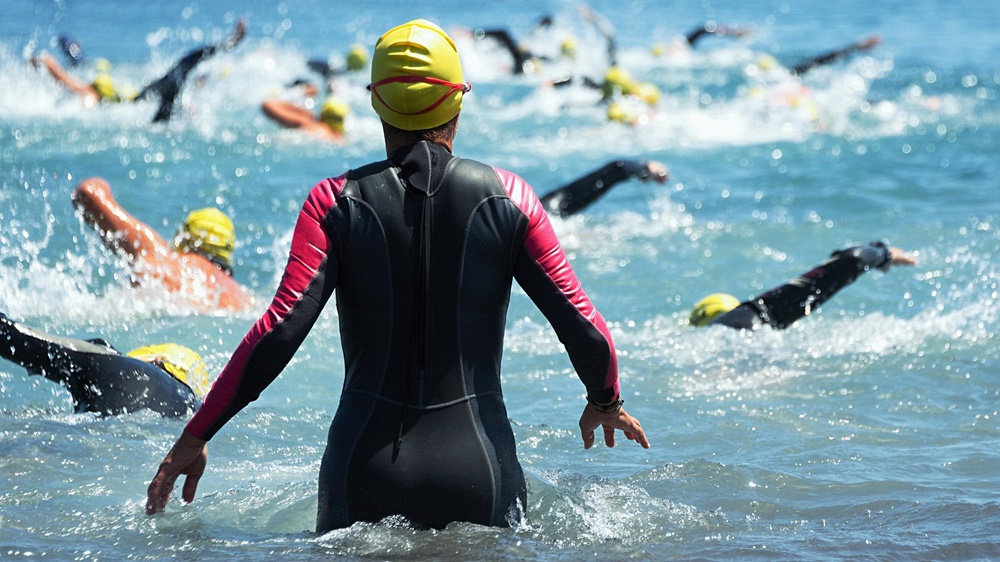Last Updated on: 18th December 2024, 12:35 pm
Swimming is crucial for triathlon performance, requiring a unique combination of technique, strength, and mental preparation. It is essential to focus on efficiency, energy conservation, and building a strong foundation for the race.
- Technique: Master swimming efficiency.
- Strength: Build power to propel through water.
- Mental Fortitude: Prepare for the race’s mental challenges.
Though swimming is a smaller portion of the triathlon, its impact is significant. A strong swim provides a competitive edge for the subsequent segments. It’s not just about speed; it’s about conserving energy for the bike and run stages.
A proficient swim positively affects overall race times. Athletes who excel in swimming often perform better in the bike and run stages, thanks to strategic energy conservation. This advantage is crucial for a controlled and powerful performance throughout the triathlon.
Integrating swimming into triathlon training is essential for those aiming for top positions. By focusing on technique, endurance, and strategic pacing, athletes can transform their swim into an opportunity to conserve energy and excel in the bike and run stages.
Building a Swimming Foundation for Triathletes
Start by assessing your current swimming skills to identify areas for improvement. Focus on refining technique, boosting endurance, and increasing speed. Understanding your starting point is crucial for targeted improvement.
- Technique: The cornerstone of efficient swimming.
- Endurance: Build stamina for the swim segment.
- Speed: Cut through the water with precision and power.
Incorporate drills and exercises into your routine to enhance swimming efficiency. Catch drills improve your pull, while kick sets build leg strength. Consistent practice of these drills leads to smoother, faster, and more efficient swimming.
Integrating swimming into triathlon training involves continuous improvement. By focusing on technique, endurance, and speed, and regularly incorporating targeted drills, triathletes can make their swim segment a powerful asset, setting the stage for a strong race.
Designing a Triathlon-Specific Swim Training Plan

Balance swim training with other triathlon disciplines to ensure each sport complements the others. This balance prevents overtraining and promotes overall athletic development.
- Frequency: Incorporate three to four swim sessions each week.
- Intensity: Mix high-intensity workouts with endurance swims.
- Volume: Balance training load to prevent overtraining.
Periodization involves timing your training to peak at the right moment. As race day approaches, tapering reduces training volume, allowing recovery and consolidation of gains. Peak training phases push your limits to ensure top form on race day.
Integrating swimming into triathlon training requires patience, persistence, and a well-thought-out plan. By balancing training, structuring swim sessions wisely, and mastering periodization, you’re preparing for a successful race day.
Overcoming Common Swimming Challenges for Triathletes

Triathletes often face challenges such as fear of open water, navigation and sighting, and mass starts. Overcoming these is crucial for a successful triathlon.
Addressing Fear of Open Water Swimming
Gradual exposure is key. Start in shallow areas and progressively venture deeper. Swim with a seasoned open-water swimmer for reassurance and insights. Familiarity builds confidence.
Strategies for Improving Navigation and Sighting in Open Water
- Practice Sighting: Lift your head enough to see ahead without halting momentum.
- Use Landmarks: Landmarks and buoys aid navigation.
Coping with Mass Starts and Maintaining Your Pace Amidst Competition
Position yourself strategically; find a spot that matches your pace and confidence. Maintain a steady pace to conserve energy. Use drafting to save energy but stay calm amidst contact.
Triathlon swimming is a mental game. By addressing open water fear, mastering navigation, and handling mass starts, you’re strategizing for success. Each stroke brings you closer to overcoming these challenges.
Maximizing Triathlon Performance: The Synergy of Swim, Bike, and Run

Transition training is crucial for triathlon success. Mastering transitions reduces race times and conserves energy. Practice these shifts to simulate race conditions and gain an edge.
Swimming’s low-impact nature is ideal for cross-training. It enhances cardiovascular health without the wear and tear of running and cycling, improving endurance and strength. Water buoyancy supports muscle recovery, making swimming excellent for active recovery days.
Swimming aids recovery and injury prevention. Its low-impact nature allows training continuity, even when injuries from high-impact activities might sideline an athlete. This ensures consistent training leading up to race day.
Integrating swimming into a triathlon training plan enhances performance, aids recovery, and prevents injury. Focus on transition training, leverage swimming’s cross-training benefits, and utilize its recovery advantages for a comprehensive training program.
Advanced Techniques and Equipment to Enhance Swim Performance
Triathletes can optimize swim performance with advanced equipment and techniques:
- Wetsuits: Provide warmth and enhance buoyancy, reducing drag and conserving energy.
- Goggles: Essential for clear vision, protecting the eyes and allowing for precise navigation.
- Caps: Reduce resistance and keep hair out of the face.
- Tech Suits: Compress muscles for improved hydrodynamics.
Master advanced swimming techniques:
- Drafting: Swim closely behind another competitor to save energy by taking advantage of their slipstream.
- Buoy Turns: Execute with agility to minimize time lost during directional changes.
- Pacing: Manage energy throughout the swim to prevent early fatigue.
Technology and data analysis transform swim training:
- GPS Watches: Track open water swims, providing insights into pace and distance.
- Stroke Rate Monitors: Help optimize efficiency.
- Underwater Cameras: Offer a unique perspective for technique refinement.
Analyzing data allows for personalized training adjustments, ensuring continuous improvement. Integrating advanced techniques and equipment into training routines sets triathletes up for success in the bike and run segments.
From Training to Race Day: Executing Your Swim Plan
Transitioning from training to race day requires a strategic approach for the swim leg. Here’s a breakdown:
Pre-race Preparation: Mental Strategies and Warm-up Routines
- Visualize the swim course: Acknowledge potential challenges and strategize your approach.
- Tailored warm-up routine: Combine dynamic stretches with a short swim to prime your muscles.
Navigating the Swim Leg: Pacing, Positioning, and Adapting to Conditions
- Maintain a steady pace: Conserve energy for the latter stages.
- Position wisely: Among competitors to avoid congestion and improve streamline.
- Adapt to changing conditions: Requires flexibility and quick thinking.
Post-swim Recovery: Transitioning Effectively to the Bike Leg
- Efficiently strip off your wetsuit: If worn, and transition your mindset from swimming to cycling.
- Quick, methodical approach to T1: Can shave precious seconds off your time, setting you up for a strong bike segment.
Executing your swim plan with precision, from pre-race preparation through to post-swim recovery, is critical for triathlon success. It’s about how well you transition into and out of the water, conserving energy and maintaining focus. With the right strategy, the swim leg can be a powerful asset.
In Closing
Swimming is essential for triathlon success. Through meticulous training, athletes refine their technique, endurance, and mental fortitude, turning the swim segment into a strategic advantage. This journey from preparation to race day execution underscores the importance of integrating swimming into triathlon training. Embrace the swim; let it propel you toward your triathlon goals.

